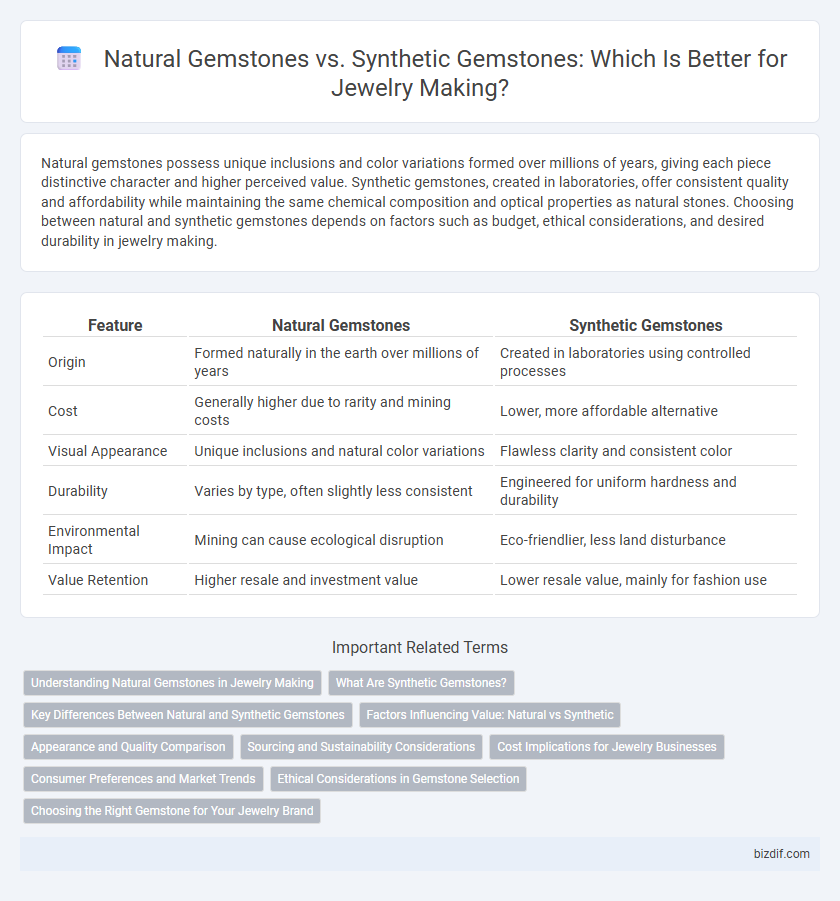Natural gemstones possess unique inclusions and color variations formed over millions of years, giving each piece distinctive character and higher perceived value. Synthetic gemstones, created in laboratories, offer consistent quality and affordability while maintaining the same chemical composition and optical properties as natural stones. Choosing between natural and synthetic gemstones depends on factors such as budget, ethical considerations, and desired durability in jewelry making.
Table of Comparison
| Feature | Natural Gemstones | Synthetic Gemstones |
|---|---|---|
| Origin | Formed naturally in the earth over millions of years | Created in laboratories using controlled processes |
| Cost | Generally higher due to rarity and mining costs | Lower, more affordable alternative |
| Visual Appearance | Unique inclusions and natural color variations | Flawless clarity and consistent color |
| Durability | Varies by type, often slightly less consistent | Engineered for uniform hardness and durability |
| Environmental Impact | Mining can cause ecological disruption | Eco-friendlier, less land disturbance |
| Value Retention | Higher resale and investment value | Lower resale value, mainly for fashion use |
Understanding Natural Gemstones in Jewelry Making
Natural gemstones in jewelry making are valued for their unique formation through geological processes over millions of years, resulting in individual color, clarity, and inclusions that cannot be replicated. These stones possess distinct mineral compositions and trace elements that contribute to their rarity and authenticity, often enhancing the piece's appeal and market value. Jewelers prioritize natural gemstones to create exclusive designs that resonate with consumers seeking originality and connection to natural beauty.
What Are Synthetic Gemstones?
Synthetic gemstones are lab-created crystals that possess the same chemical composition, physical properties, and optical qualities as natural gemstones, offering a more affordable and environmentally friendly alternative. These gems undergo controlled processes such as hydrothermal synthesis or flame fusion to replicate natural formation conditions, resulting in stones free from natural inclusions and often superior clarity. Jewelers and consumers value synthetic gemstones for their consistent quality, ethical sourcing, and versatility in fine jewelry designs.
Key Differences Between Natural and Synthetic Gemstones
Natural gemstones are formed through geological processes over millions of years, exhibiting unique inclusions and variations that enhance their rarity and value. Synthetic gemstones are created in laboratories with controlled conditions, offering identical chemical and physical properties at a lower cost and with fewer imperfections. The primary differences lie in origin, price, rarity, and the presence of natural inclusions versus synthetic clarity.
Factors Influencing Value: Natural vs Synthetic
Natural gemstones derive value from their rarity, unique inclusions, and geological origin, which often results in higher market demand and collector interest. Synthetic gemstones offer consistent quality, fewer imperfections, and lower cost due to controlled laboratory production, but their value is generally lower compared to natural counterparts. Factors influencing value include authenticity, clarity, color saturation, and the presence of natural inclusions, which distinguish natural stones from synthetics.
Appearance and Quality Comparison
Natural gemstones exhibit unique inclusions and color variations that enhance their authenticity and individual character, while synthetic gemstones offer consistent clarity and color due to controlled manufacturing processes. Quality-wise, natural stones often possess higher value attributed to rarity and natural formation, whereas synthetic stones provide durability and flawlessness at a more affordable price point. Both types are widely used in jewelry making, allowing artisans to balance aesthetic appeal with budget and design preferences.
Sourcing and Sustainability Considerations
Natural gemstones are ethically sourced from mines with varying environmental impacts, often requiring extensive land disruption and water use, which raises sustainability concerns. Synthetic gemstones, created in laboratories through controlled processes, offer a more eco-friendly alternative by reducing mining-related ecological damage and conserving natural resources. Choosing synthetic options contributes to sustainable jewelry making by minimizing carbon footprint and promoting ethical sourcing transparency.
Cost Implications for Jewelry Businesses
Natural gemstones typically command higher prices due to their rarity, unique inclusions, and mining expenses, impacting jewelry businesses' inventory costs and pricing strategies. Synthetic gemstones offer a cost-effective alternative with consistent quality and availability, enabling businesses to reduce production costs and increase profit margins. Balancing customer demand for authenticity with cost-efficiency remains crucial for jewelers managing natural versus synthetic gemstone selections.
Consumer Preferences and Market Trends
Consumer preferences in jewelry making increasingly favor natural gemstones due to their unique inclusions and perceived value, despite the rising affordability of synthetic gemstones. Market trends reveal a growing demand for ethical and sustainable sourcing, which benefits both natural gemstones with verified origins and high-quality synthetic alternatives. Retail data shows millennials and Gen Z buyers particularly appreciate the environmental benefits and consistent quality of synthetic stones, influencing market dynamics significantly.
Ethical Considerations in Gemstone Selection
Natural gemstones often hold higher ethical concerns due to mining practices that can involve environmental degradation and exploitative labor conditions. Synthetic gemstones, created in controlled laboratory settings, provide a sustainable and conflict-free alternative, reducing the impact on ecosystems and improving worker welfare. Selecting synthetic options supports ethical jewelry making by promoting transparency and responsible sourcing within the industry.
Choosing the Right Gemstone for Your Jewelry Brand
Natural gemstones, prized for their unique inclusions and rarity, often command higher value and appeal among luxury jewelry brands seeking authenticity. Synthetic gemstones, created in laboratories with controlled conditions, offer consistent quality, vibrant color, and ethical sourcing, making them a cost-effective choice for brands prioritizing sustainability and affordability. Selecting between natural and synthetic gemstones depends on your brand's target market, budget constraints, and commitment to environmental and social responsibility.
Natural gemstones vs synthetic gemstones Infographic

 bizdif.com
bizdif.com